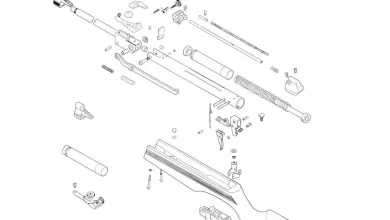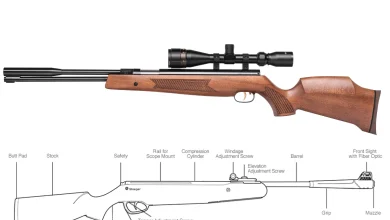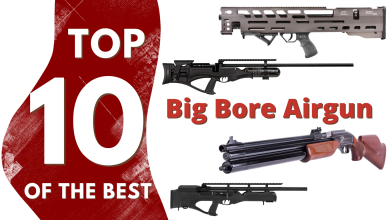How To Choosing the Perfect AirGun?
Explore key factors to consider when selecting the perfect airgun

Airguns, also known as pellet guns or air rifles, have gained popularity due to their accessibility, affordability, and versatility. With various types and models available in the market, selecting the best airgun can be a daunting task. But worry not! In this comprehensive guide, we’ll walk you through the essential factors to consider when choosing the perfect airgun to suit your needs and preferences.
Below is a table summarizing the key factors to consider when choosing the perfect airgun:
| Factor | Description |
|---|---|
| Types of Air guns | Understand the different types available, including spring-piston, pneumatic (PCP or multi-pump), and CO2-powered. |
| Intended Use | Determine the primary purpose of your airgun, such as target shooting, pest control, small game hunting, or competition. |
| Caliber Selection | Choose the appropriate caliber (e.g., .177 or .22) based on your shooting needs and preferences. |
| Velocity and Energy | Consider the speed and force with which the pellets are propelled, depending on your intended use and shooting range. |
| Accuracy and Range | Look for an airgun with consistent accuracy and an appropriate shooting range for your activities. |
| Powerplant and Cocking | Decide on the type of powerplant (e.g., spring-piston or PCP) and the cocking mechanism that suits your comfort level. |
| Build Quality and Materials | Check the build quality and materials to ensure durability and weather resistance. |
| Optics and Sights | Ensure the airgun comes with quality sights or offers mounting options for scopes and other optics. |
| Noise Level | Consider the noise level of the airgun, especially if you prefer a quieter shooting experience. |
| Test Before Purchase | Whenever possible, try out different airgun models to assess ergonomics, trigger quality, accuracy, and noise level. |
| Budget Considerations | Set a realistic budget, considering the airgun’s price, additional costs, and value for money. |
| Popular Airgun Brands | Research reputable and trusted brands known for their reliability and innovation. |
| Safety Precautions | Prioritize safety by following essential precautions and using appropriate safety gear. |
| Maintenance and Care | Learn how to maintain and care for your airgun to ensure optimal performance and longevity. |
| Accessories and Upgrades | Explore various accessories and upgrades to enhance your shooting experience. |
| Research and Reviews | Conduct thorough research and read reviews to learn from other users’ experiences. |
| Legal Considerations | Be aware of the legal regulations regarding airguns in your area and comply with them. |
| Seek Expert Advice | If unsure, seek advice from experienced shooters or airgun enthusiasts for guidance. |
Factors to Consider for Choosing the Perfect AirGun
Types of Airguns
Before delving into the selection process, let’s understand the different types of airguns available:
- Spring-Piston Airguns: Spring-powered airguns are one of the most common types. They use a coiled spring and a piston to compress air. When you cock the gun, the spring compresses, and upon trigger pull, it releases the compressed air, propelling the pellet forward. These airguns are relatively easy to use and maintain, making them an excellent choice for beginners.
- Pneumatic Airguns: Pneumatic airguns utilize compressed air or gas to propel the pellets. They can be further categorized into:
- Pre-Charged Pneumatic (PCP) Airguns: PCP airguns come with an external air reservoir that needs to be filled with a high-pressure air source, like a hand pump or scuba tank. They offer consistent and powerful shots, making them popular among serious shooters.
- Multi-Pump Pneumatic Airguns: These airguns require manual pumping to build air pressure. The more you pump, the higher the pressure and subsequent velocity of the pellet. Multi-pump airguns are versatile and suitable for various shooting distances.
- CO2-Powered Airguns: CO2 airguns utilize small CO2 cartridges that are inserted into the gun. When the trigger is pulled, the CO2 gas expands, propelling the pellet. These airguns are easy to use and maintain, and they offer semi-automatic or automatic firing options in some cases.
Considerations before Buying an Airgun
Selecting the best airgun involves thoughtful consideration of several factors. Let’s dive into the crucial aspects to keep in mind:
- Intended Use: Determine the primary purpose of your airgun. Are you planning to use it for target practice, plinking, pest control, small game hunting, or competitive shooting? Different airguns are designed for specific applications, so it’s essential to align your intended use with the gun’s capabilities.
- Caliber Selection: Airgun calibers typically range from .177 to .50, with .177 and .22 being the most common. .177 caliber pellets are lightweight and travel at higher velocities, making them suitable for target shooting and pest control. On the other hand, .22 caliber pellets are heavier and deliver more knockdown power, making them better suited for hunting small game.
- Velocity and Energy: The velocity of an airgun determines the speed at which the pellet travels, while the muzzle energy indicates the force with which it hits the target. Consider the velocity and energy requirements based on your intended use. For example, target shooting may not require high velocities, while hunting will demand sufficient energy for a clean kill.
- Accuracy and Range: Accuracy is crucial for any shooting activity. Look for an airgun with consistent accuracy and a suitable range based on your shooting preferences. Keep in mind that shooting range can be influenced by factors such as pellet type, wind, and shooter’s skill.
- Powerplant and Cocking Mechanism: Decide on the type of powerplant that suits you best – spring-piston, pneumatic (PCP or multi-pump), or CO2. Additionally, consider the cocking mechanism, especially if you’re physically limited. Some airguns have break barrels, side levers, or bolt-action systems for cocking, while PCP guns require less effort to cock.
- Build Quality and Materials: Look for an airgun made from high-quality materials to ensure durability and longevity. Airguns with synthetic stocks are more weather-resistant, while those with wooden stocks provide a classic appeal.
- Optics and Sights: Check if the airgun comes with integrated sights or if it has mounting options for scopes and other optics. Quality sights or the ability to mount scopes will enhance your shooting experience, especially for target shooting or hunting.
- Noise Level: Depending on your shooting environment, noise level might be a significant consideration. If you plan to shoot in a residential area or prefer a quieter shooting experience, look for airguns equipped with noise reduction features.
Test Before Purchase
Before making a final decision, try to test the airgun if possible. Visit a local shooting range or a store with a shooting range facility to get hands-on experience with different models. Testing an airgun will provide you with the following benefits:
- Ergonomics and Comfort: Assess how the airgun feels in your hands. Check if the stock length and shape suit your physique, as comfort is crucial for consistent shooting.
- Trigger Quality: A smooth and predictable trigger is vital for accuracy. Test the trigger pull and reset to see if it meets your expectations.
- Noise and Recoil: Get a sense of the noise level and recoil of the airgun. A loud or overly jarring airgun might affect your shooting experience, especially for beginners.
- Accuracy: Test the airgun’s accuracy by shooting at different distances and positions. This will give you a better understanding of its capabilities and limitations.
- Cocking and Loading: If the airgun requires manual cocking or loading, check how comfortable and easy the process is for you.
Budget Considerations
Budget plays a crucial role in selecting the best airgun. Prices can vary significantly based on the type, brand, features, and quality of the airgun. Here are some budget considerations to keep in mind:
- Set a Realistic Budget: Determine the maximum amount you are willing to spend on an airgun. Setting a budget will help you narrow down your options and avoid overspending.
- Consider Additional Costs: Apart from the airgun itself, consider any additional costs such as pellets, targets, maintenance accessories, and shooting range fees.
- Value for Money: While it’s essential to stick to your budget, also consider the value you get for the price. Sometimes, investing a bit more upfront might provide you with a more reliable and satisfying shooting experience in the long run.
Popular Airgun Brands
Choosing a reputable and trusted brand can make a significant difference in the quality and performance of your airgun. Here are some popular airgun brands known for their reliability and innovation:
| Brand | Description |
|---|---|
| Crosman | A well-established brand offering a wide range of airguns suitable for all skill levels. Crosman is known for its affordable and reliable airguns. |
| Gamo | Gamo is recognized for producing high-velocity airguns, making them suitable for hunting and competitive shooting. Their airguns often feature sleek designs and advanced technology. |
| Benjamin | Benjamin, owned by Crosman, is known for its PCP air rifles and powerful break barrels. They are favored by hunters and serious shooters alike. |
| Hatsan | Hatsan is a Turkish brand known for producing high-quality PCP airguns. Their models often feature customizable features and robust build quality. |
| Umarex | Umarex offers a diverse range of airguns, including licensed replicas of popular firearms. They are known for their CO2-powered airguns and realistic design aesthetics. |
Safety Precautions
Before you embark on your airgun journey, safety should be your top priority. Here are some essential safety precautions to follow:
- Treat Every Airgun as if it’s Loaded: Always assume that the airgun is loaded and ready to fire. Never point it at anything you don’t intend to shoot.
- Always Use a Suitable Backstop: Ensure you have a proper backstop that can stop pellets safely. Never shoot towards hard surfaces or water, as pellets can ricochet unpredictably.
- Keep the Muzzle Pointed in a Safe Direction: Avoid pointing the muzzle at yourself or others, even if the airgun is not loaded. Always keep it pointed in a safe direction.
- Wear Eye Protection: Protect your eyes with shooting glasses or safety goggles whenever you’re shooting or around others who are shooting.
- Store Airguns and Ammunition Securely: Store your airgun and pellets in a locked cabinet or safe, away from unauthorized access and children.
Maintenance and Care
Proper maintenance and care are essential to keep your airgun in top-notch condition and ensure its longevity. Here are some tips to maintain your airgun:
- Regular Cleaning: Clean your airgun regularly, especially after shooting sessions. Use a cleaning rod, patches, and cleaning solvents designed specifically for airguns. This will help remove dirt, debris, and lead residue, ensuring smooth operation.
- Lubrication: Apply the appropriate lubricant to the necessary parts of your airgun as per the manufacturer’s guidelines. Proper lubrication will reduce friction and prevent wear and tear.
- Storage: When storing your airgun for an extended period, make sure it is free from moisture and extreme temperatures. Store it in a cool, dry place, and consider using a gun case or sleeve for added protection.
- Seals and O-Rings: Check the seals and O-rings regularly for any signs of damage or wear. Replace them as needed to maintain a proper air seal and prevent air leaks.
- Spring-Piston Maintenance: If you own a spring-piston airgun, avoid leaving it cocked for an extended period, as this can cause fatigue in the spring. Uncock the gun when not in use to prolong its lifespan.
- PCP Airgun Maintenance: For PCP airguns, ensure you have the necessary equipment, such as a hand pump or scuba tank, to fill the air reservoir. Regularly check the pressure level and refill it as required for consistent performance.
Accessories and Upgrades
Enhance your shooting experience with various accessories and upgrades available for airguns. Here are some popular options:
- Optics: Invest in a quality scope or red dot sight to improve your accuracy and target acquisition. There are various types and magnifications available to suit your shooting style.
- Bi-Pods: Bi-pods provide stability and support during shooting, especially for hunting or long-range shooting sessions.
- Silencers/Suppressors: If noise reduction is a concern, consider adding a silencer or suppressor to your airgun. Be sure to check local regulations regarding their legality.
- Pellet Types: Experiment with different pellet types to find the best match for your airgun. There are various shapes and weights available, each with its unique flight characteristics.
- Upgraded Triggers: Some airguns allow for trigger upgrades to improve the trigger pull and enhance shooting precision.
Research and Reviews
Before making your final decision, conduct thorough research on the airguns you are considering. Look for reviews and feedback from other users to gain insight into their real-world performance and reliability. Online forums, social media groups, and dedicated airgun websites can be valuable sources of information. Keep in mind that everyone’s preferences and experiences may differ, so consider multiple viewpoints.
Legal Considerations
Be aware of the legal regulations concerning airguns in your area. Different regions may have specific laws and restrictions regarding the use, possession, and transportation of airguns. Ensure you comply with these regulations to avoid any legal issues. Additionally, be mindful of the minimum age requirements for owning or using airguns, especially when purchasing them for younger shooters.
Seek Expert Advice
If you’re still unsure about the best airgun for your needs, consider seeking advice from experienced shooters, sports professionals, or airgun enthusiasts. They can provide valuable insights and guidance based on their own experiences, helping you make an informed decision.
Conclusion
Choosing the best airgun is an exciting journey that requires careful consideration of various factors, from the type of airgun to your intended use, budget, and safety. By understanding the different types of airguns, performing hands-on tests, and researching reputable brands, you can narrow down your options and find the perfect match. Remember to prioritize safety, practice responsible shooting, and maintain your airgun regularly for optimal performance. Whether you’re a seasoned shooter or a newcomer to the world of airguns, the right choice will provide you with countless hours of enjoyment and skill development. Happy shooting and stay safe!
FAQs
Discover the different types of airguns, from spring-piston to PCP and CO2-powered models. Understand their unique features and applications to find the one that aligns with your shooting needs.
Learn about the importance of caliber selection and find out which one is best suited for small game hunting or precise target shooting.
Understand the impact of accuracy on your shooting experience and explore tips to enhance it.
Find out the benefits of PCP airguns and whether they are worth the investment for serious shooters.
Prioritize safety with essential tips for handling airguns responsibly and protecting yourself and others.
Learn about the importance of hands-on testing and where you can try out different airgun models.
Read More:



